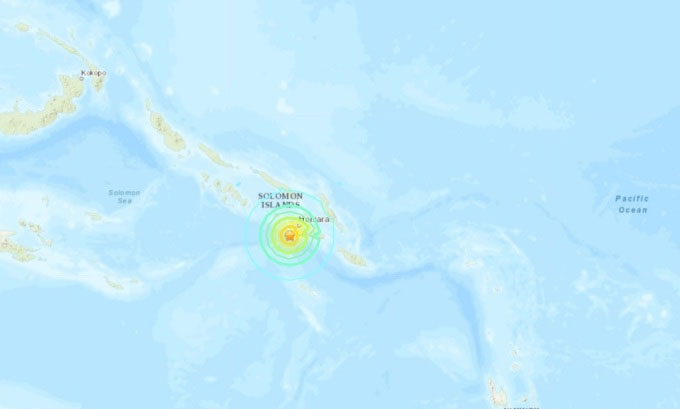Today, the moment magnitude scale is used as the standard for measuring large earthquakes, while smaller earthquakes still utilize the Richter scale.
A strong earthquake occurred off the coast of the Solomon Islands on November 22, triggering a tsunami warning for areas within 300 kilometers of the epicenter. The United States Geological Survey (USGS) initially reported a magnitude of 7.3, but later revised it to 7.0. So, what causes earthquakes, and how is their intensity measured?

A magnitude 7.0 earthquake struck off the coast of the Solomon Islands on November 22. (Graphic: USGS).
Earthquakes, or seismic events, are the result of the sudden release of energy in the Earth’s crust, primarily caused by the movement of tectonic plates. These plates are constantly shifting and rubbing against each other. Sometimes, the forces and friction build up enough to cause tremors and break the ground. The location where tectonic plates meet and create a “fault point” beneath the surface is called the focus. The epicenter is the point on the ground directly above the focus.
When an earthquake occurs, seismic waves travel through the ground, causing vibrations that can be measured by a seismometer. This instrument consists of a series of sensors that help determine and record the magnitude of earthquakes, in other words, it is used to assess the intensity of an earthquake, according to Mometrix Academy.
In its basic operational principle, a seismometer resembles a weight suspended on a spring and attached to a fixed frame. Any movement from the ground shifts the frame, while the weight tends to remain still due to its inertia. By measuring the movement between the frame and the weight, the ground motion can be determined.
Today, there are several scales to assess the strength of earthquakes, but the moment magnitude scale has become the standard used by seismic agencies like the USGS for medium to large earthquakes, replacing the original Richter scale.
Simulation of seismometer operation. (Video: Geologist Hassan).
The Richter scale (denoted as ML) was invented in the 1930s to provide some insight into earthquake intensity. The Richter scale corresponds to the base-10 logarithm of the amplitude of seismic waves (the logarithm of a number is the exponent to which a fixed value – called the base – must be raised to produce that number). Each whole number increase on the Richter scale represents a tenfold increase in amplitude but corresponds to approximately 31.6 times more energy release.
For example, a 6.0 magnitude earthquake has an amplitude ten times greater than a 5.0 magnitude earthquake, but the energy released is about 31.6 times greater.
According to the USGS, there are up to 1.4 million earthquakes above 2.0 on the Richter scale each year, but only 16 earthquakes reach a magnitude of 7 or higher. In fact, an earthquake must have a magnitude of 2.0 or greater for it to be felt by people on the surface.
Today, the USGS only uses ML for earthquakes with a magnitude less than 3.5 on the Richter scale. This is because the Richter scale is not suitable for larger earthquakes. According to Weather, the upper limit of this scale is about 7.0, meaning that for earthquakes stronger than this, the measurement results become nearly saturated (for the same value).
The moment magnitude scale (denoted as Mw) was developed in 1979 to succeed the Richter scale. This is a tool for measuring the total energy released by an earthquake. It allows scientists to use computer models to create synthetic seismic images and accurately determine how the released energy relates to the intensity of an earthquake, essentially how far a fault has moved and the force required to move it.
The moment magnitude scale also uses logarithms like the Richter scale, and smaller earthquakes have approximately the same intensity on both scales. However, Mw has the advantage of not saturating with larger earthquakes, making it the standard and most widely used measure today. The moment magnitude is expressed in units without Richter. For example, the devastating earthquake and tsunami in Tohoku, Japan in 2011 had a magnitude of 9.0.
Another tool for measuring earthquakes is the Modified Mercalli Intensity Scale. This scale is based on observed effects from earthquakes and the level of perception of those effects. It was also developed in the 1930s and uses Roman numerals from I to XII to indicate the intensity level of an earthquake, according to Seeker. For example:
- Intensity II: is weak and described as “felt only by a few people resting, especially on the upper floors of buildings.”
- Intensity VI: is a strong earthquake and “felt by everyone, causing many to be frightened. Some heavy objects are moved; in some cases, plaster falls from the ceiling, causing minor damage.”
- Intensity XII: the highest level described as “causing total destruction; objects thrown into the air.”
Instead of assigning numbers to logarithms, the intensity of an earthquake on the Modified Mercalli scale relates to the distance of someone or something from the earthquake’s epicenter at the time it occurs. This means that different intensity measurements can be obtained depending on where you take the measurement. The type of ground that a person or object is standing on during the earthquake also plays a significant role in determining its intensity. Soft ground shakes more violently than hard ground.


















































